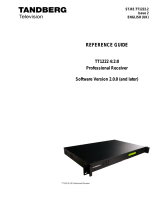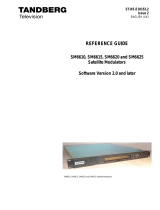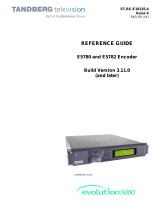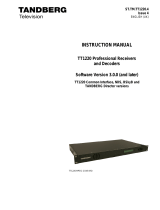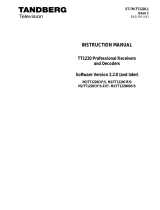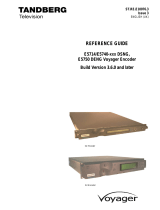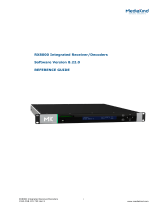Page is loading ...

ST.US.E10274.1
ENGLISH (UK)
www.tandbergtv.com
RX8310/15/30
Distribution Receivers
USER GUIDE
RX8310/RX8315/RX8330
Distribution Receiver
Software Version 1.3.0

RX8310/RX8315/RX8330 Distribution Receiver
2
Trademarks
Dolby
®
/ Dolby
®
Digital / AC-3
®
are registered trademarks of Dolby Laboratories Licensing
Corporation.
Customer Services
Europe, Middle East Tel: +44 (0) 23 8048 4455
and Africa: Fax: +44 (0) 23 8048 4467
Americas: Tel: +888 671 1268 (US and Canada)
Tel: +678 812 6255 (Outside of mainland US)
China: Tel: +86 10 6856 0260 (Beijing)
Tel: +852 2530 3215 (Hong Kong)
Australia/NZ: Tel: +612 8923 0450
Internet Address: http://www.tandbergtv.com
Technical Training
International: Tel: +44 (0) 23 8048 4229
Fax: +44 (0) 23 8048 4467
This document and the information contained in
it is the property of TANDBERG Television Ltd
and may be the subject of patents pending and
granted. It must not be used for commercial
purposes nor copied, disclosed, reproduced,
stored in a retrieval system or transmitted in
any form or by any means (electronic,
mechanical, photocopying, recording or
otherwise), whether in whole or in part, without
TANDBERG Television’s prior written agreement.
© 2009 TANDBERG Television Ltd.
All rights reserved.
Issue 1 first published in 2009 by:
TANDBERG Television Ltd
Registered Address:
Unit 2 Strategic Park, Comines Way,
Hedge End, Southampton,
Hampshire,
SO30 4DA
United Kingdom
Registered Company Number 03695535

RX8310/RX8315/RX8330 Distribution Receiver
3
Contents
1 Who Should Use This User Guide? ...........................................................................5
1.1 What Equipment is Covered by This User Guide?........................................................5
1.2 Hardware and Software Options....................................................................................5
2 Installing the Equipment .............................................................................................7
2.1 Introduction ....................................................................................................................7
2.2 Operating Voltage..........................................................................................................7
2.3 Power Cable and Earthing.............................................................................................7
2.4 Rear Panel Connectors..................................................................................................7
2.5 Connecting the Receiver to the Power Supply............................................................10
3 Operating the Equipment From the Front Panel.....................................................11
3.1 Introduction ..................................................................................................................11
3.2 Receiver Front Panel ...................................................................................................11
3.3 Using the Front Receiver Panel Menu System............................................................11
4 Operating the Equipment From A Web Browser....................................................13
4.1 Introduction ..................................................................................................................13
4.2 Receiver Web Browser Interface.................................................................................13
4.3 Using the Receiver Web Browser Interface.................................................................14
4.4 Page Structure.............................................................................................................14
5 Quick Start Guide - Using the Front Panel Control................................................17
5.1 Making Signal Connections to the Unit........................................................................17
5.2 Configuring the Inputs..................................................................................................17
5.3 Selecting a Decode Service (Program) .......................................................................18
5.4 Configuring the Video Output.......................................................................................19
5.5 Configuring the Audio Outputs.....................................................................................19
5.6 Configuring for Single-service Decryption ...................................................................19
5.7 Configuring for Multi-service Decryption......................................................................19
6 Equipment Packaging ...............................................................................................20
6.1 Packaging Statement...................................................................................................20
6.2 Packaging Markings.....................................................................................................20
7 Materials Declarations...............................................................................................22
7.1 Overview ......................................................................................................................22
7.2 For the European Union...............................................................................................22
7.3 For China .....................................................................................................................22

RX8310/RX8315/RX8330 Distribution Receiver
4
8 Disposal of this Equipment.......................................................................................23
8.1 General.........................................................................................................................23
8.2 For the European Union...............................................................................................23
9 Recycling ....................................................................................................................24
List of Figures
Figure 2.1: Rear Panel Connectors (RX8310/BAS)................................................................8
Figure 2.2: Rear Panel Connectors (RX8315/BAS with RX83XX/HWO/IP) ...........................8
Figure 2.3: Rear Panel Connectors (RX8330/BAS with RX83XX/HWO/IP) ...........................9
Figure 3.1: Front Panel LEDs and Pushbuttons....................................................................11
Figure 4.1: Example Status Tab - Web Control for an RX8310 Receiver.............................14
List of Tables
Table 1.1: Equipment Model Descriptions...............................................................................5
Table 1.2: RX8310/RX8315/RX8330 Hardware Options........................................................5
Table 1.3: RX8310/RX8315/RX8330 Software Option............................................................6
Table 1.4: RX8310/RX8330 Specific Software Options..........................................................6
Table 1.5: RX8315/RX8330 Specific Software Options..........................................................6
Table 2.1: Types of Connector................................................................................................9
Table 2.2: Fuse Type and Rating..........................................................................................10

RX8310/RX8315/RX8330 Distribution Receiver
5
1 Who Should Use This User Guide?
This User Guide is written for operators/users of the RX8310, RX8315 and
RX8330 Distribution Receivers to assist in installation and operation.
WARNING
Do not remove the covers of this equipment. Hazardous voltages are
present within this equipment and may be exposed if the covers are
removed. Only TANDBERG Television trained and approved service
engineers are permitted to service this equipment.
CAUTION
Unauthorised maintenance or the use of non-approved replacements
may affect the equipment specification and invalidate any warranties.
1.1 What Equipment is Covered by This User Guide?
Table 1.1: Equipment Model Descriptions
Model Number Marketing Code Description
RX8310 RX8310/BAS Distribution Receiver. DVB-S2,
Director V5 CA, ac mains voltage input.
RX8315 RX8315/BAS Distribution Receiver. DVB-S2, Common
Interface CA, Director V5 CA, ac mains
voltage input.
RX8330 RX8330/BAS Distribution Receiver. DVB-S2, Common
Interface CA, Director V5 CA, SDI output,
ac mains voltage input.
1.2 Hardware and Software Options
Table 1.2: RX8310/RX8315/RX8330 Hardware Options
Marketing Code Description
RX83XX/HWO/IP/OUT Dual gigabit IP output card

RX8310/RX8315/RX8330 Distribution Receiver
6
Table 1.3: RX8310/RX8315/RX8330 Software Option
Marketing Code Description
RX83XX/SWO/DVBS2/QPSK DVB-S2 QPSK License key
RX83XX/SWO/DVBS2/8PSK DVB-S2 8PSK License key
RX83XX/SWO/DVBS2/LSYM DVB-S2 Low Symbol Rate License Key
RX83XX/SWO/PW Password Protection for Web Browser
RX83XX/SWO/MPEG2/SD MPEG-2 SD decoding
RX83XX/SWO/MPEG2/HD MPEG-2 HD decoding and MPEG-2 HD down
conversion
RX83XX/SWO/MPEG4/SD MPEG-4 AVC SD decoding
RX83XX/SWO/MPEG4/HD MPEG-4 AVC SD decoding and MPEG-4 AVC HD
down conversion
RX83XX/SWO/AC3
Dolby Digital
®
decoding / downmixing
Table 1.4: RX8310/RX8330 Specific Software Options
Marketing Code Description
RX83XX/SWO/DIR5/MSD TANDBERG Director 5 Multi-Service License key
Table 1.5: RX8315/RX8330 Specific Software Options
Marketing Code Description
RX83XX/SWO/MSD TANDBERG Common Interface Multi-Service License
key

RX8310/RX8315/RX8330 Distribution Receiver
7
2 Installing the Equipment
2.1 Introduction
Use this User Guide for guidance on installation and operation. Only use
installation accessories recommended by the manufacturers.
2.2 Operating Voltage
CAUTION
This product should be operated only from the type of power source
indicated on the marking label. If you are not sure of the type of power
supply to your business, consult a qualified electrical engineer or your
local power company.
AC Models
AC models are fitted with a wide-ranging power supply. It is suitable for supply
voltages of 100-240 V ac -10% +6% at 50/60 Hz nominal.
2.3 Power Cable and Earthing
Check that the power cable is suitable for the country in which the Receiver is to
be used.
WARNINGS
1. The Technical Earth is not a protective earth for electric
shock protection.
2. This unit must be correctly earthed through the moulded
plug supplied. If the local mains supply does not have an
earth conductor do not connect the unit. Before connecting
the unit to the supply, check the supply requirements.
Contact Customer Services for advice.
2.4 Rear Panel Connectors
Always use the specified cables supplied for signal integrity and compliance with
EMC requirements (see Reference Guide).

RX8310/RX8315/RX8330 Distribution Receiver
8
Figure 2.1: Rear Panel Connectors (RX8310/BAS)
CONDITIONAL ACCESS INTERFACE
Figure 2.2: Rear Panel Connectors (RX8315/BAS with RX83XX/HWO/IP)
A
LARM
A
SI INPUT
TECHNICAL
EARTH
ETHERNET 1 & 2
RF IN 1,2,3,4
A
SI OUT
A
UDIO OUT 1 & 2
CVBS
RF IN 1,2,3,4 IP OUT 1 & 2
A
UDIO OUT 1 & 2
TECHNICAL
EARTH
ETHERNET 1 & 2
or
CONTROL 1 & 2
A
SI OUT CVBS
A
LARM
CONDITIONAL
A
CCESS
INTERFACE
A
SI INPUT

RX8310/RX8315/RX8330 Distribution Receiver
9
CONDITIONAL ACCES S INTERFACE
ASI / SDI OUT
ASI / SDI OUT
Figure 2.3: Rear Panel Connectors (RX8330/BAS with RX83XX/HWO/IP)
Table 2.1: Types of Connector
Type of Connector Description
CVBS 1 & 2
75 Ω BNC connector for SD composite video output
RF IN 1,2,3 & 4 F-type connectors for DVB or DVB-S2 modulated input feed
AUDIO OUT 1 & 2 9-way male D-type connectors for analogue and balanced digital
audio output
IP OUT 1 & 2 8-way RJ-45 connectors for 1000BaseT IP output feed
ETHERNET/CONTROL
1 & 2 or
CONTROL 1 & 2
8-way RJ-45 connectors for 10/100BaseT Ethernet control and
monitoring.
ASI IN
75 Ω BNC connector for ASI input feed
ALARM 9-way male D-type connector for alarm signal output
TECHNICAL EARTH Spade connector for unit technical earth
ASI OUT 1 & 2
75 Ω BNC connector for ASI output feeds
ASI/SDI OUT 1 & 2
75 Ω BNC connector for ASI or SDI (user selectable) output
feeds
A
SI / SDI OUT
CONDITIONAL
A
CCESS
INTERFACE
A
LARM ETHERNET 1 & 2
or
CONTROL 1 & 2
A
SI INPUT
CVBS
TECHNICAL
EARTH
A
UDIO OUT 1 & 2
IP OUT 1 & 2RF IN 1,2,3,4

RX8310/RX8315/RX8330 Distribution Receiver
10
2.5 Connecting the Receiver to the Power Supply
WARNINGS
1. Do not overload wall outlets and extension cords as this
can result in a risk of fire or electric shock
2. As no mains switch is fitted to this unit, ensure the local
power supply is switched OFF before connecting the supply
cord.
3. The Receiver is not fitted with an on/off switch. Ensure that
the socket-outlet is installed near the equipment so that it is
easily accessible. Failure to isolate the equipment properly
may cause a safety hazard.
Connect the Receiver to the power supply as follows:
!Power Supply
Ensure the power supply is isolated and switched off.
!Receiver
Ensure the correct fuse type and rating has been fitted to both the equipment
and the power cable.
!Supply Cord
Connect the lead to the Receiver input connector and then to the power
supply. Switch on the power supply.
Table 2.2: Fuse Type and Rating
Power Supply Fuse Type and Rating
100 - 240 V ac IEC/EN 60127-2 Sheet 5
Bussmann S505/Littelfuse 215
2 A 250 V T HBC

RX8310/RX8315/RX8330 Distribution Receiver
11
3 Operating the Equipment From the Front Panel
3.1 Introduction
The front panel display and keypad may be used to configure, control and monitor
the Receiver when an external control system or PC is not used.
NOTE
Not all of the receiver User Settings may be viewed or changed from
the front panel. The full set of User Settings may be found on the Web
browser control interface.
The reference guide contains a list of receiver User Settings which may be viewed
or changed via the front panel and those which may be viewed or changed via the
external web browser interface.
3.2 Receiver Front Panel
Figure 3.1: Front Panel LEDs and Pushbuttons
3.3 Using the Front Receiver Panel Menu System
3.3.1 Arrow Pushbuttons
The four arrow pushbuttons are used to navigate through the receiver menu
system. Each arrow pushbutton backlight is illuminated when a further menu can
be reached by pressing that pushbutton.
Save
Right
Down
LCD display
Edit
Up
Left
Status LED
USB Serial

RX8310/RX8315/RX8330 Distribution Receiver
12
3.3.2 Edit and Save Pushbuttons
The edit and save pushbuttons are used to modify User Settings within the menu
system. The edit pushbutton backlight is illuminated when the current menu
contains a user modifiable setting. To modify a User Setting within a menu, press
the edit pushbutton and then use the up and down pushbuttons to change the
User Setting. During this edit operation, both the edit and save pushbutton
backlights will be illuminated.
If a menu contains more than one modifiable User Setting then the left and right
pushbuttons are used to select which User Setting will be edited.
When a User Setting has been modified, the save pushbutton should be pressed
to confirm and action this new User Setting.
3.3.3 Menu Structure
The range of modifiable User Settings will vary depending on which receiver model
is being used. All models have the User Settings arranged within the following
top-level menus:
• System: This menu contains User Settings for:
IP Control ports set-up
IP Control ports link status
Unit Build version details
Unit Electronic Serial Number
• Input: This menu contains User Settings for:
Input feed lock status and bit-rate
Primary and secondary input feed selection
Input feed tuning parameters
Input feed signal and quality levels
• Service (Program): This menu contains User Settings for:
The currently selected service for decode from the incoming feed
• CA: This menu contains User Settings for:
The currently selected services for decryption from the incoming feed
Director 5 parameters and status
More detail on all User Settings may be found in the Reference Guide.

RX8310/RX8315/RX8330 Distribution Receiver
13
4 Operating the Equipment From A Web Browser
4.1 Introduction
A PC Web Browser may be used to configure, control and monitor the Receiver.
The PC must be connected to either of the two IP control ports on the rear of the
receiver (labelled ETHERNET 1 and 2 or CONTROL 1 and 2). Before operation,
the User Settings for the control port must be entered via the system menu on the
front panel.
If the receiver is connected to an existing network or is not on the same subnet as
the control PC then assistance from the network administrator may be required in
modifying the User Settings.
To assist with troubleshooting, the IP control ports will respond to ICMP PING
request messages.
The reference guide contains more detail on all receiver User Settings available on
the Web Browser Interface.
4.2 Receiver Web Browser Interface
To use the receiver Web Browser Interface, the IP address assigned to the
receiver control port in the front panel system menu should be entered into the
address field of the Web browser.
Provided that the network is correctly configured, the following status page should
be automatically loaded and displayed.

RX8310/RX8315/RX8330 Distribution Receiver
14
Figure 4.1: Example Status Tab - Web Control for an RX8310 Receiver
4.3 Using the Receiver Web Browser Interface
The User Settings that may be viewed or modified from the Web Browser interface
are grouped together by function and are displayed on a number of pages. These
pages can be viewed by selecting the relevant tabs.
After any changes are made to User Settings, the ‘Apply Changes’ button must be
pressed to action the changes.
4.4 Page Structure
All models have the user setting pages selectable from the following tabs:

RX8310/RX8315/RX8330 Distribution Receiver
15
• Status: This page contains User Settings for:
Unit name and IP address
Input feed status
Video decode status
Audio decode status
Decryption status
Unit alarm status and log
• Device Info: This page contains User Settings for:
IP Control Ports Set-up
Unit and module build version details
Fan and unit temperature status
SNMP trap table
Unit reset
• Alarms: This page contains User Settings for:
Alarm filtering
Alarm priority configuration
Alarm mapping to output relays
• Customisation: This page contains User Settings for:
Enabled license details
• Input: This page contains User Settings for:
Input feed lock status and bit-rate
Primary and secondary feed selection
Input tuning parameters
Input signal and quality levels
• Service (Program): This page contains User Settings for:
The currently selected service for decode from the incoming feed
The currently selected PCR component from the incoming feed
The currently selected video component from the incoming feed
The currently selected audio components from the incoming feed
The currently selected splice signal components from the incoming feed
The currently selected subtitle and teletext components from the
incoming feed
The currently selected services for decryption from the incoming feed
Service selection behaviour control
Video decode aspect ratio conversion control
Video test pattern selection
Audio output control
VBI data output control

RX8310/RX8315/RX8330 Distribution Receiver
16
• Output: This page contains User Settings for:
Selection and configuration of the output feeds
• Download: This page contains User Settings for:
Status of in-band software download.
• SNMP: This page contains User Settings for:
Protocol selection
MIB parameters
• Presets: This page contains User Settings for:
Save and recall of unit presets
• Save/Load: This page contains User Settings for:
Saving and restoring unit configuration
Saving unit logs
Saving unit MIBs
• Help: This page contains User Settings for:
Using the web interface

RX8310/RX8315/RX8330 Distribution Receiver
17
5 Quick Start Guide - Using the Front Panel Control
5.1 Making Signal Connections to the Unit
!If you have an incoming satellite RF feed, connect this to the rear panel
connector marked RF Input
!If you have an incoming ASI (Fiber) feed, connect this to the connector
marked ASI Input
!Decoded PAL or NTSC video is output on connectors CVBS 1 and CVBS 2.
These outputs are identical in operation.
! Decoded analogue or digital audio is output on connectors AUDIO OUT 1
and AUDIO OUT 2. Adaptor cables are used to provide the connector type
required for the installation.
!The incoming feed is routed through the unit and output on connectors
ASI OUT 1 and ASI OUT 2
!For models with option RX83XX/HWO/IP/OUT fitted, the incoming feed is
also routed through the unit and output on connectors IP OUT 1 and
IP OUT 2
!If the unit is to be controlled by Web browser or PC based control system
then the control PC should be connected to connector CONTROL 1 or
CONTROL 2
!If the unit is to be used to decrypt (non-Director) encrypted feeds then a
Conditional Access Module and card should be inserted in the slot labelled
Conditional Access Interface in the rear panel
5.2 Configuring the Inputs
5.2.1 ASI Input
To configure the unit for ASI (Fiber) input.
!Select ASI input from a submenu off menu 2
5.2.2 Satellite (DVB-S or DVB-S2) Input
Ensure that the incoming feed is connected to connector 1.
To configure the unit for Satellite input the following User Settings should be
modified. All of these settings may be found in submenus off front panel menu 2.

RX8310/RX8315/RX8330 Distribution Receiver
18
!Select SAT input
Set the LNB frequency
Set the Satellite frequency
Set the Symbol Rate
Set the Modulation scheme and FEC
Set the Roll-Off
Set the set the LNB power output
Set the set the LNB power output level
A description of each of these User Settings can be found in the Reference Guide.
NOTE
If the unit has successfully locked to the incoming feed, then the TS
Lock value in menu 2 should be LOCKED.
5.3 Selecting a Decode Service (Program)
Navigate to the Service Selection menu (Menu 3).
!For incoming feeds containing only a single service the service will be
selected automatically
!For incoming feeds containing more than one service press Edit and, using
the Up and Down pushbuttons, scroll through the service name list. Then
press Save to select the required service.
!Alternatively, use the Right pushbutton to move the cursor to the service ID
field and press Edit. Enter the required service ID using the Up and Down
pushbuttons for each digit of the service ID.
NOTE
If the unit has successfully selected a service, then menu 3 should
display the Service ID and Service name.

RX8310/RX8315/RX8330 Distribution Receiver
19
5.4 Configuring the Video Output
!The unit will automatically decode the first video component that it finds
within the selected service.
!An alternative video component may be selected from the service tab on the
Web Control interface.
NOTE
If the incoming feed is High Definition video and the unit has the
relevant decode licenses enabled then the output is automatically
downconverted to Standard Definition at the CVBS connector.
5.5 Configuring the Audio Outputs
!The unit will automatically decode the first two audio components that it finds
within the selected service.
!Alternative audio components may be selected from the service tab on the
Web Control interface
5.6 Configuring for Single-service Decryption
!If the service selected for video decode (see Section 5.3) contains encrypted
components these components will automatically be decrypted by the unit.
!The outgoing feed from the unit will contain these decrypted components.
5.7 Configuring for Multi-service Decryption
!When a feed containing more than one encrypted services is applied to the
unit, the first 24 services detected are automatically decrypted. A list of these
services can be found in the service table off front panel menu 4.
!This list may be modified from the CA tab on the Web Control interface.
NOTE
This is only applicable for units models that have Multi-service
Decryption licenses enabled.

RX8310/RX8315/RX8330 Distribution Receiver
20
6 Equipment Packaging
6.1 Packaging Statement
The outer carton and any cardboard inserts are made from 82% recycled material
and are fully recyclable.
6.2 Packaging Markings
The symbols printed on the outer carton are described below:
Handle with care
This way up
Fragile
Protect from moisture
Defines country of origin.
See Reference Guide for details of
compliance with directives.
See Reference Guide for details of
compliance.
/
